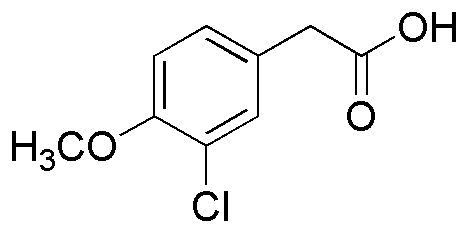2-(3-Chloro-4-methoxyphenyl)acetic acid is widely utilized in research focused on:
- Pharmaceutical Development: This compound serves as an important intermediate in the synthesis of various pharmaceuticals, particularly in developing anti-inflammatory drugs.
- Agricultural Chemicals: It is used in formulating herbicides, providing effective weed control while minimizing environmental impact.
- Analytical Chemistry: The compound is employed in analytical methods for detecting and quantifying specific biological markers, aiding in medical diagnostics.
- Biochemical Research: It plays a role in studying enzyme interactions and metabolic pathways, contributing to advancements in biochemistry.
- Material Science: This chemical is explored in the development of new materials with enhanced properties, such as improved thermal stability and chemical resistance.
General Information
Properties
Safety and Regulations
Applications
2-(3-Chloro-4-methoxyphenyl)acetic acid is widely utilized in research focused on:
- Pharmaceutical Development: This compound serves as an important intermediate in the synthesis of various pharmaceuticals, particularly in developing anti-inflammatory drugs.
- Agricultural Chemicals: It is used in formulating herbicides, providing effective weed control while minimizing environmental impact.
- Analytical Chemistry: The compound is employed in analytical methods for detecting and quantifying specific biological markers, aiding in medical diagnostics.
- Biochemical Research: It plays a role in studying enzyme interactions and metabolic pathways, contributing to advancements in biochemistry.
- Material Science: This chemical is explored in the development of new materials with enhanced properties, such as improved thermal stability and chemical resistance.
Documents
Safety Data Sheets (SDS)
The SDS provides comprehensive safety information on handling, storage, and disposal of the product.
Product Specification (PS)
The PS provides a comprehensive breakdown of the product’s properties, including chemical composition, physical state, purity, and storage requirements. It also details acceptable quality ranges and the product's intended applications.
Certificates of Analysis (COA)
Search for Certificates of Analysis (COA) by entering the products Lot Number. Lot and Batch Numbers can be found on a product’s label following the words ‘Lot’ or ‘Batch’.
Número de catálogo
Número de lote/lote
Certificates Of Origin (COO)
This COO confirms the country where the product was manufactured, and also details the materials and components used in it and whether it is derived from natural, synthetic, or other specific sources. This certificate may be required for customs, trade, and regulatory compliance.
Número de catálogo
Número de lote/lote
Safety Data Sheets (SDS)
The SDS provides comprehensive safety information on handling, storage, and disposal of the product.
DownloadProduct Specification (PS)
The PS provides a comprehensive breakdown of the product’s properties, including chemical composition, physical state, purity, and storage requirements. It also details acceptable quality ranges and the product's intended applications.
DownloadCertificates of Analysis (COA)
Search for Certificates of Analysis (COA) by entering the products Lot Number. Lot and Batch Numbers can be found on a product’s label following the words ‘Lot’ or ‘Batch’.
Número de catálogo
Número de lote/lote
Certificates Of Origin (COO)
This COO confirms the country where the product was manufactured, and also details the materials and components used in it and whether it is derived from natural, synthetic, or other specific sources. This certificate may be required for customs, trade, and regulatory compliance.


